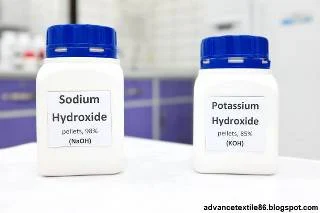Sodium hydroxide
Sodium
hydroxide (NaOH) is a corrosive white crystalline solid that easily absorbs
moisture until it dissolves. This is usually called caustic soda or lye. It is
the most used industrial alkali. It is highly corrosive to animal and plant
tissues. After dissolving in water, it neutralizes the acid in alkaline
solutions in various commercial processes. In petroleum refining, it removes
sulfuric and organic acids. In making soap it reacts with fatty acids and makes
soap and glycerin. NaOH solutions are used in the treatment of cellulose and in
the production of many chemicals.
Formula:
NaOH
Molar
mass: 39.997 g/mol
Density:
2.13 g/cm³
Boiling
point: 1,388 °C
IUPAC
ID: Sodium hydroxide, Sodium oxidative
Soluble
in: Water, Ethanol, Methanol
Properties of sodium hydroxide
i.
Sodium hydroxide is a white deliquescent solid having a melting point of 591 K
(318°C)
ii.
It is stable towards heat
iii.
It is highly soluble in water and a considerable amount of heat is evolved.
iv.
It is also soluble in alcohol
v.
The aqueous solution of sodium hydroxide is strongly alkaline
vi.
The solution of sodium hydroxide is soapy to the touch.
vii.
It has a bitter taste.
viii.
A concentrated solution of sodium hydroxide can damage the skin when it comes
in contact with the skin.
ix.
It reacts violently with Acids.
x.
Its molecular weight is 40.01gm/mol.
xi.
Its boiling point is 1390°C
xii.
Its specific gravity is 2.13
xiii.
It is an inorganic compound with the formula NaOH.
xiv.
It is highly soluble in water and smoothly absorbs moisture and carbon dioxide
from the air.
xv.
It forms a series of hydrates
xvi.
It is insoluble in ether and other non-polar solvents.
xvii.
It has a characteristic viscosity, 78 mPa·s, that is much greater than that of
water 1.0 mPa·s
xviii.
It also reacts with acidic oxides,
xix.
It can be used for the base-driven hydrolysis of esters, amides, and alkyl
halides, for soap making.
xx.
Solid sodium hydroxide is mostly sold as flakes, prills, and cast blocks.
Preparation of sodium hydroxide
The
preparation of sodium hydroxide is industrial as 50% dissolved by
using the process of the electrolytic chloralkali. Chlorine gas is also
produced in this process. Solid sodium hydroxide is produced from this solution
by the evaporation of water. Solid sodium hydroxide is mostly sold as flakes,
prills, and cast blocks.
Preparation of sodium hydroxide by treating sodium carbonate in a metathesis reaction
with calcium hydroxide which assumes the fact that sodium hydroxide is soluble,
while calcium carbonate does not. This process was called causticizing.
Ca
(OH)2 (aq) + Na2CO3 (s) → CaCO3 (s)
+ 2 NaOH (aq)
This process was repulsed by the Solvay process in the late 19th century, which is
what we use today by the chloralkali process that changed today.
Sodium
hydroxide is also produced by combining pure sodium metal with water. The
byproducts are hydrogen gas and heat, often forming a flame.
2Na
+ 2H2O → 2NaOH + H2
Sodium hydroxide uses
i.
Sodium hydroxide uses to make sodium salts and detergents, pH control, and
organic synthesis.
ii.
It is used in many situations where it is recommended to increase the alkalinity of a mixture or neutralize the acid.
iii.
It is used as an additive in bentonite mud systems to increase alkalinity, to
increase mud viscosity, and use drill mud to neutralize any acid gas.
iv.
It is used with hydrochloric acid to balance pH.
v. Sodium hydroxide uses to make soaps and detergents. It is used for hard bar soap while
potassium hydroxide is used for liquid soap. It is used more than potassium
hydroxide because it is cheaper and requires less.
vi.
It is used as a sewage cleaner that converts sodium hydroxide-containing fats
and greases that can clog pipes as soap that dissolves in water.
vii.
It is used to make synthetic textile fibers like rayon.
viii.
It is also used in the manufacture of paper.
ix.
It is used to refine bauxite ore from which aluminum metal is extracted and it
is known as the Bayer process.
x.
It is used in metallic neglect, oil refining, and making dyes and bleaches.
xi.
It is used during water purification to raise the pH of water supplies.
xii.
It is used for the detection of carbon monoxide poisoning
Safety
Like
other corrosive acids and alkalis, drops of sodium hydroxide solution can
easily decompose proteins and lipids in living tissues through amide hydrolysis
and ester hydrolysis, causing chemical burns and causing permanent blindness to
eye contact. Solid alkalis can also reveal their corrosive nature if there is
water-like water vapor. Thus, protective equipment such as rubber gloves,
protective clothing, and eye protection should always be used when handling
this chemical or its solutions. The measure of early treatment for the spread
of alkali on the skin is, like other erosive, plenty of water irrigation. The
wash is run for at least ten to fifteen minutes.










0 Comments